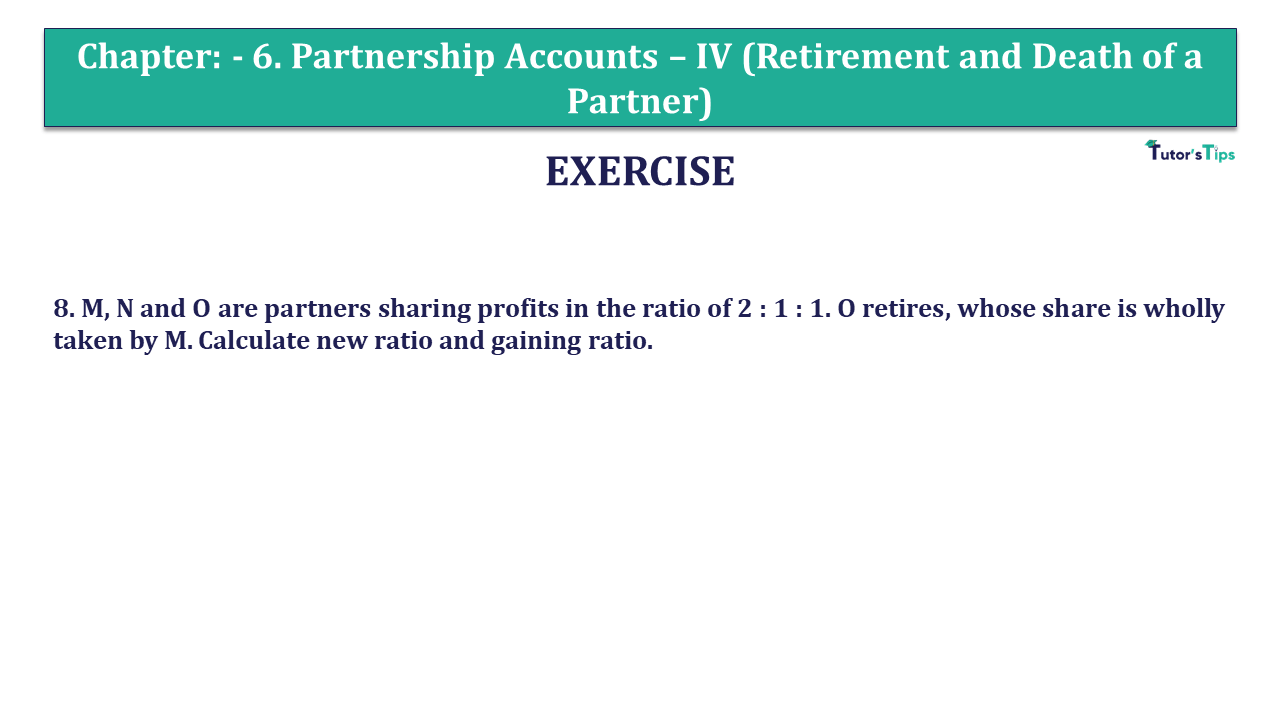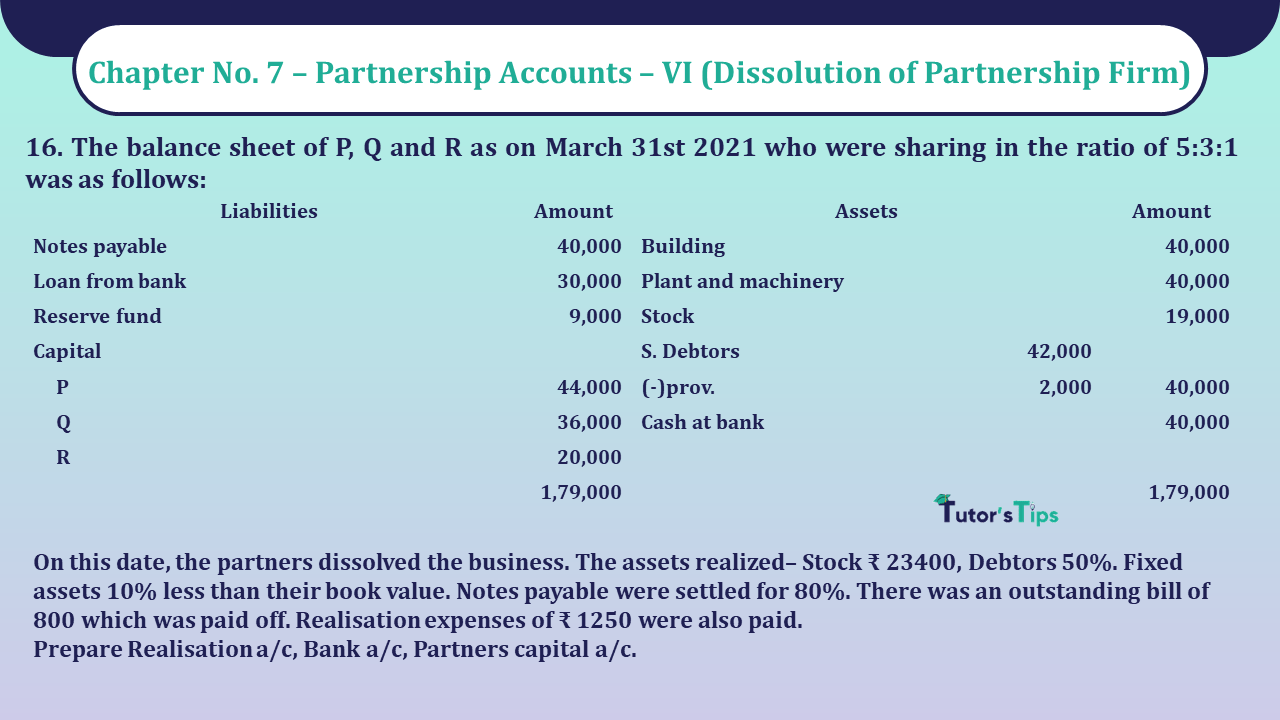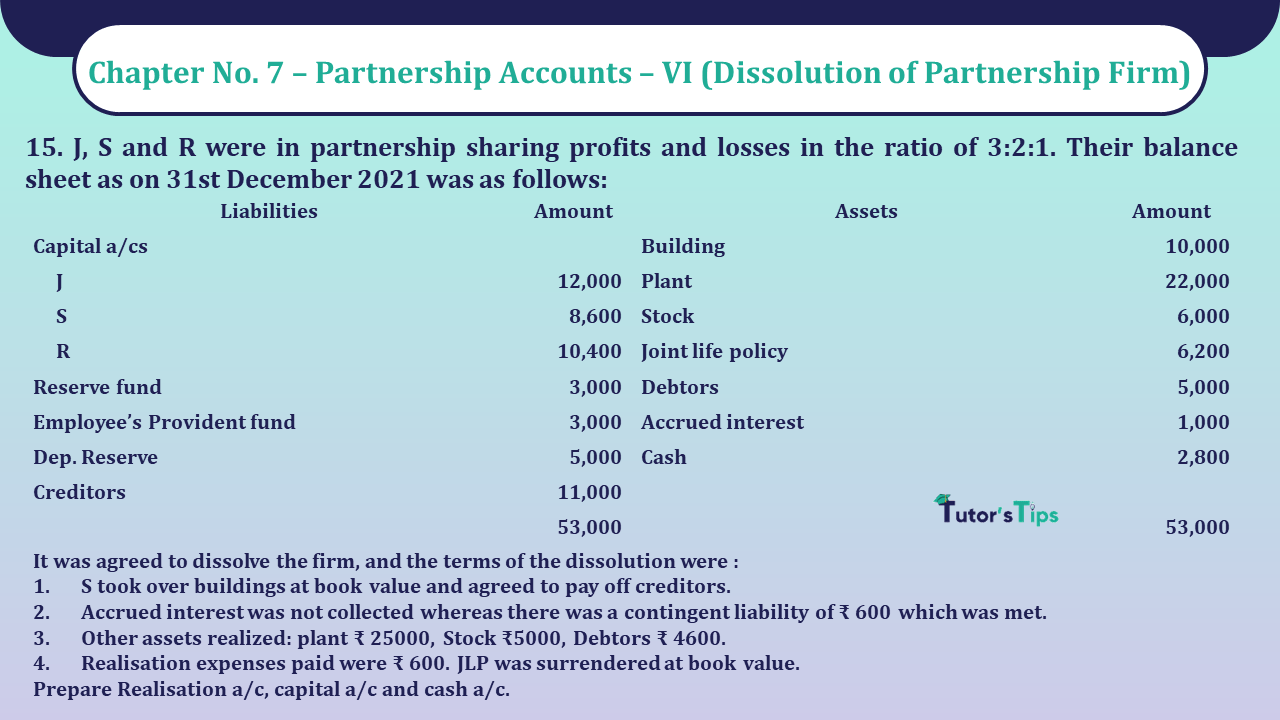Question 66 Chapter 5 – Unimax Class 12 Part 1 – 2021
66. A and B were partners in a firm sharing profits and losses in the ratio of 3 : 2. Their Balance Sheet on 1st January, 2021 was as follows :
| Liabilities | Amount | Assets | Amount |
| Sundry Creditors | 15000 | Plant | 30000 |
| Capital : | Patents | 10000 | |
| A | 30,000 | Debtors | 18000 |
| B | 25,000 | Stock | 20000 |
| Reserves | 10,000 | Cash | 2000 |
| 80,000 | 80,000 |
C is admitted as a partner on the above date on the following terms.
- He will pay Rs. 10000 as his share of goodwill and will get 1/4th share in the profits of the firm.
- The assets are to be valued as under Plant at Rs. 32000, Stock at Rs. 18000, Debtors at book figure less a provision of 5% for doubtful debts.
- It was found that creditors include a sum of Rs. 1400 which was not to be paid. But it was also found that there was a liability for compensation to workers amounting to Rs. 2000.
- C was to introduce Rs. 20000 as capital and the capitals of the other partners were to be adjusted in the new profit sharing ratio. For this purpose Current Accounts were to be opened.
Give Journal entries to record the above and Balance Sheet after C’s admission.
The solution of Question 66 Chapter 5 – Unimax Class 12 Part 1: –
Revaluation A/c
| Particulars | Rs. | Particulars | Rs. | |
| To Provision for bad debts a/c | 900 | By Plant a/c | 2000 | |
| To Stock a/c | 2000 | By Creditors a/c | 1400 | |
| To Worker’s compensation fund a/c | 2000 | By Loss on revaluation | ||
| A (3 : 2) | 900 | |||
| B | 600 | 1500 | ||
| 4,900 | 4,900 |
Capital Accounts
| Particulars | A | B | C | Particulars | A | B | C |
| To Loss on revaluation | 900 | 600 | – | By Balance b/d | 30,000 | 25,000 | – |
| To Current a/c | 5100 | 8400 | – | By Reserve a/c | 6,000 | 4,000 | – |
| To Balance c/d | 36000 | 24000 | 20000 | By Cash a/c | – | – | – |
| By Premium a/c (3 :2) | 6,000 | 4,000 | 20,000 | ||||
| 42000 | 33000 | 20,000 | 42,000 | 33,000 | 20,000 |
Balance Sheet
| Liabilities | Rs. | Assets | Rs. | ||
| Sundry Creditors | 13600 | Plant | 32000 | ||
| Capital Accounts | Debtors | 18000 | |||
| A | 36000 | Less : Provision | 900 | 17100 | |
| B | 24000 | Cash (2000 + 20000 + 10000) | 32000 | ||
| C | 20000 | 80000 | Patents | 10000 | |
| A’s Current a/c | 5100 | Stock | 18000 | ||
| B’s Current a/c | 8400 | ||||
| Worker’s Compensation Fund | 2000 | ||||
| 1,09,100 | 1,09,100 |
Working Note:
(A) Calculation of Capitals of Partners :
Total Capital of firm = 4/1 X 20000 = Rs. 80000
(i) A’s required capital = 9/20 X 80000 = Rs. 36000
A’s actual capital Rs. 41100
A will withdraw Rs. 5100
(ii) B’s required capital = 6/20 X 80000 = Rs. 24000
B’s actual capital = Rs. 32400
B will withdraw = Rs. 8400
(iii) C’s capital = Rs. 20000
(B) Calculation of New PSR :
Let Total profit = 1
C’s Share = 1/4
Remaining share = 3/4
A’s new share = 3/5 X 3/4 = 9/20
B’s new share = 2/5 X 3/4 = 6/20
C’s share = 1/4
New PSR = 9 : 6: 5 (New PSR)
(C) Sacrificing Ratio is 3 : 2 as if nothing has been decided in partnership deed.
Advertisement-X
Journal
| Date | Particulars | L.F. | Debit | Credit | |
| Revaluation a/c | Dr. | 4,900 | |||
| To Stock A/c | 2,000 | ||||
| To Provision for bad debts a/c | 900 | ||||
| To Worker’s compensation fund a/c | 2,000 | ||||
| (Being value of assets decreased & new liability created) | |||||
| Plant a/c | Dr. | 2,000 | |||
| Creditors A/c | Dr. | 1,400 | |||
| To Revaluation A/c | 3,400 | ||||
| (Being value of assets increased & liability decreased.) | |||||
| A’s Capital a/c | Dr. | 900 | |||
| B’s Capital a/c | Dr. | 600 | |||
| To Revaluation a/c | 1,500 | ||||
| (Being loss on revaluation transferred to old partner’s capital a/c) | |||||
| General Reserve a/c | Dr. | 10,000 | |||
| To A’s capital a/c | 6,000 | ||||
| To B’s capital a/c | 4,000 | ||||
| (Being reserve fund distributed among old partners) | |||||
| Bank a/c | Dr. | 30,000 | |||
| To C’s capital A/c | 20,000 | ||||
| To Premium a/c | 10,000 | ||||
| (Being capital and goodwill brought by new partner) | |||||
| Premium a/c | Dr. | 10,000 | |||
| To A’s Capital a/c | 6,000 | ||||
| To B’s Capital a/c | 4,000 | ||||
| (Being goodwill distributed among old partners’ in sacrificing ratio) | |||||
| A’s Capital a/c | Dr. | 5,100 | |||
| B’s capital a/c | Dr. | 8,400 | |||
| To A’s capital a/c | 5,100 | ||||
| To B’s capital a/c | 8,400 | ||||
| (Being withdrawn by old partners and transferred to their current a/c) |
What is Partnership – Meaning and Its 4 Types
T.S. Grewal’s Double Entry Book Keeping +2 (Vol. I: Accounting for Not-for-Profit Organizations and Partnership Firms)
- Chapter No. 1 – Financial Statement of Not-For-Profit Organisations
- Chapter No. 2 – Accounting for Partnership Firms – Fundamentals
- Chapter No. 3 – Goodwill: Nature and Valuation
- Chapter No. 4 – Change in Profit-Sharing Ratio Among the Existing Partners
- Chapter No. 5 – Admission of a Partner
- Chapter No. 6 – Retirement/Death of a Partner
- Chapter No. 7 – Dissolution of a Partnership Firm
T.S. Grewal’s Double Entry Book Keeping (Vol. II: Accounting for Companies)
- Chapter No. 8 – Company Accounts – Accounting for Share Capital
- Chapter No. 9 – Company Accounts – Issue of Debentures
- Chapter No. 10 – Redemption of Debentures
T.S. Grewal’s Double Entry Book Keeping (Vol. II: Accounting for Companies)
- Chapter No. 1 – Financial Statements of a Company
- Chapter No. 2 – Financial Statement Analysis
- Chapter No. 3 – Tools of Financial Statement Analysis – Comparative Statements and Common- Size Statements
- Chapter No. 4 – Accounting Ratios
- Chapter No. 5 – Cash Flow Statement
Check out T.S. Grewal +2 Book 2020@ Official Website of Sultan Chand Publication







Leave a Reply